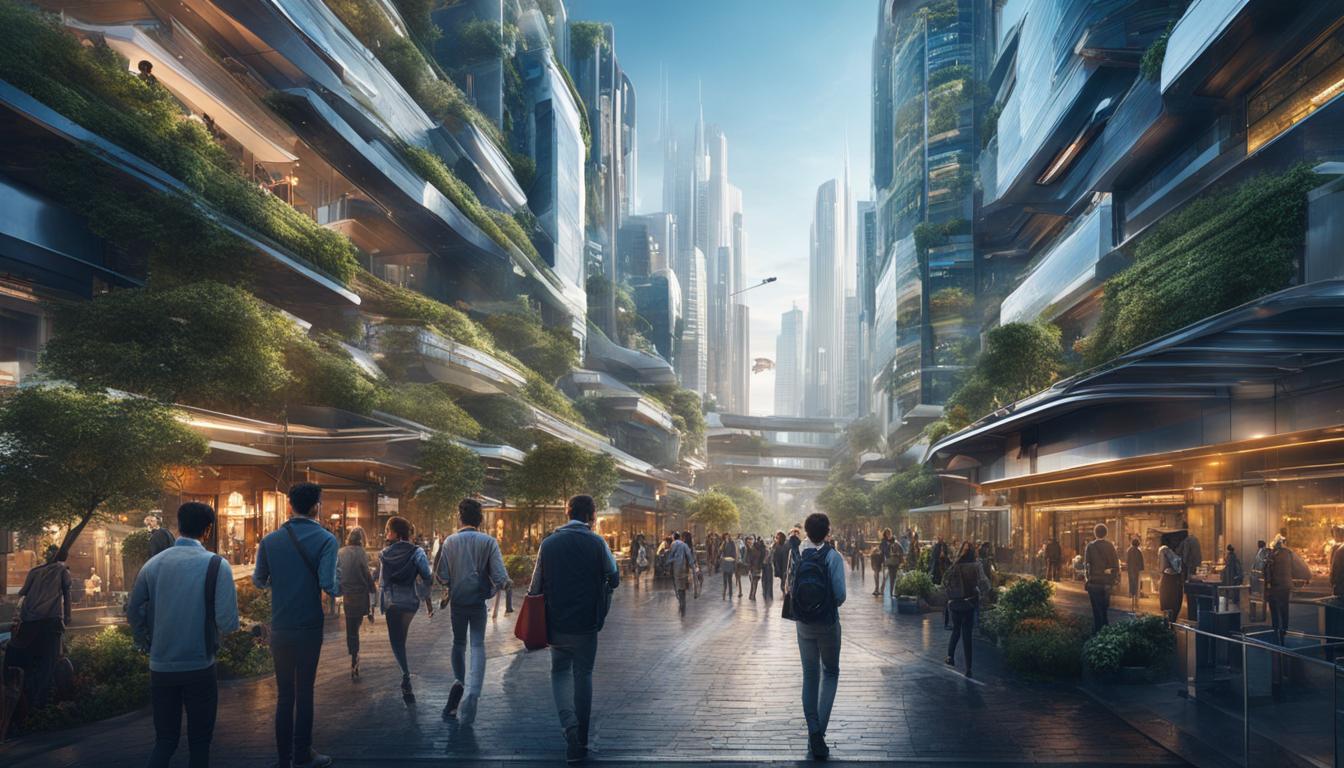Immerse yourself in the fascinating realm of smart living, where artificial intelligence (AI) merges with technology to revolutionize our daily lives. The integration of AI in areas like home automation and customized healthcare has revolutionized our interactions with the environment, ushering in a time of heightened convenience and effectiveness.
In this article, we will explore the various ways AI is shaping smart living and how it can enhance our quality of life. Whether it’s controlling your home through voice commands or leveraging AI-powered solutions for traffic management in smart cities, we’ll delve into the endless possibilities that AI technology offers.
Join us as we navigate the next frontier of smart living, embracing the potential of AI to make our lives smarter, more connected, and more enjoyable.
Key Takeaways:
- AI and IoT have brought about a new era of smart living, transforming the way we interact with our surroundings.
- AI-driven virtual assistants and IoT-enabled devices empower users to control and manage their homes remotely.
- Wearable devices equipped with AI capabilities are revolutionizing healthcare by allowing individuals to monitor their vital signs and take proactive measures towards their well-being.
- Smart city solutions powered by AI enhance traffic management, waste management, energy optimization, and public safety.
- In the retail sector, AI and IoT enable personalized customer engagement and optimized supply chain management.
Enhancing Home Automation with AI
The integration of artificial intelligence (AI) with the Internet of Things (IoT) has revolutionized the concept of smart living. Home automation, in particular, has been greatly enhanced through the use of AI-driven virtual assistants and IoT-enabled devices. These technological advancements empower users to control and manage their homes remotely, providing convenience, efficiency, and a personalized experience.
By incorporating AI-driven virtual assistants into IoT devices, homeowners can seamlessly interact with their smart homes. Whether it’s adjusting the thermostat, turning off lights, or receiving real-time security notifications, AI technology offers a new level of control and convenience. With a simple voice command or through a mobile app, users can easily manage their home’s various smart devices.
This combination of AI and home automation opens up a whole new world of possibilities. For example, personalized experiences can be created based on users’ preferences and habits. AI technology can learn from user behavior and adapt to their needs, providing tailor-made solutions for an enhanced smart living experience.
| Benefits of AI in Home Automation | Examples |
|---|---|
| Convenience and efficiency | Automated lighting and temperature control |
| Energy optimization | Smart thermostats that adjust based on occupancy and weather conditions |
| Enhanced security | Real-time monitoring and notification systems |
| Personalized experiences | Customized settings based on user preferences |
The future of home automation lies in the seamless integration of AI and IoT technologies. As the global AI in the IoT market continues to grow, companies have the opportunity to develop user-friendly interfaces and innovative solutions that will further enhance the home automation experience. With AI-driven virtual assistants and IoT-enabled devices, smart living is becoming more accessible and tailored to individual preferences.
Next, we will explore how AI and IoT are revolutionizing the healthcare industry.
Revolutionizing Healthcare with AI and IoT
In the healthcare industry, the combination of AI and IoT has sparked a revolution, transforming the way we approach patient care and well-being. With the help of wearable devices equipped with AI capabilities, individuals now have the power to monitor their vital signs and analyze health data in real-time. This remote monitoring capability empowers individuals to take proactive measures towards their well-being, leading to improved health outcomes.
Businesses in the healthcare sector have recognized the immense potential of AI-IoT solutions and are collaborating with healthcare providers, insurance companies, and wearable technology manufacturers to develop innovative healthcare systems. Through these collaborations, remote monitoring systems have been created, enabling healthcare professionals to have a comprehensive view of their patients’ health status from a distance, resulting in more efficient and personalized care.
The integration of AI and IoT in healthcare has not only enhanced patient care but has also created substantial revenue streams for businesses in the healthcare sector. AI-IoT healthcare solutions have paved the way for improved efficiency in resource allocation, reduced healthcare costs, and better utilization of medical resources. Additionally, the collection and analysis of vast amounts of health data have opened up opportunities for predictive analytics, leading to early detection and prevention of diseases.
Table: AI-IoT Healthcare Solutions
| Solution | Description |
|---|---|
| Remote patient monitoring | Enables healthcare professionals to monitor patients’ health data remotely, leading to improved personalized care and reduced hospital visits. |
| Telehealth services | Allows patients to receive medical consultations and advice remotely, improving access to healthcare resources, especially for those in rural or underserved areas. |
| AI-powered diagnosis | Utilizes AI algorithms to analyze medical imaging and diagnostic data, aiding in early detection and accurate diagnosis of diseases. |
| Medication management | Uses AI-powered systems to remind patients to take medications on time, ensuring adherence to treatment plans and reducing medication errors. |
By revolutionizing healthcare through the integration of AI and IoT, we are creating a future where individuals have greater control over their health and receive more personalized and efficient care. The potential for AI in healthcare is vast, and as technology continues to advance, we can expect even more groundbreaking innovations that will further improve the quality of healthcare and overall well-being.
Building Smart Cities with AI-IoT Technologies
The advancement of AI and IoT technologies is revolutionizing urban living, paving the way for the development of smart cities. With smart cities, we can leverage AI-powered solutions to address key urban challenges, enhance public safety, optimize energy consumption, and efficiently manage traffic and waste. The seamless integration of AI and IoT in smart city initiatives has the potential to improve the quality of life for citizens while creating revenue opportunities for businesses.
AI-powered traffic management systems are transforming the way we navigate our cities. By using real-time data from sensors and cameras, these systems can optimize traffic flow, reduce congestion, and enhance overall transportation efficiency. This not only saves time and reduces stress for commuters but also leads to lower fuel consumption and decreased emissions, contributing to a greener and more sustainable urban environment.
Waste management is another area that benefits from AI-enabled solutions. By leveraging IoT sensors and AI algorithms, cities can optimize waste collection routes, monitor bin fill levels, and implement proactive waste management strategies. This results in reduced costs, improved efficiency, and a cleaner, healthier environment for residents.
Energy optimization is a critical aspect of building smart cities. AI and IoT technologies enable the implementation of smart grids and energy management systems that monitor and optimize energy consumption in real-time. By analyzing data from smart meters, weather forecasts, and building sensors, cities can identify energy-saving opportunities, reduce peak loads, and promote the use of renewable energy sources. These initiatives not only reduce energy costs but also contribute to a more sustainable and resilient urban infrastructure.
Table: Key Benefits of AI-IoT Technologies in Smart Cities
| Area | Benefit |
|---|---|
| Traffic Management | Reduced congestion, improved transportation efficiency, lower fuel consumption |
| Waste Management | Optimized collection routes, proactive waste management, cost reduction |
| Energy Optimization | Real-time energy monitoring, reduced peak loads, increased use of renewable energy sources |
| Public Safety | Smart surveillance, crime prevention, emergency management |
Ensuring public safety is also a critical aspect of building smart cities. AI-powered surveillance systems can detect and respond to potential security threats more effectively, enabling proactive crime prevention and emergency management. By analyzing real-time video feeds and integrating data from various sources, cities can enhance situational awareness, improve response times, and create a safer environment for residents and visitors.
In conclusion, the integration of AI and IoT technologies is transforming cities into smart, efficient, and sustainable environments. From traffic management to waste management, energy optimization, and public safety, AI-IoT solutions offer numerous benefits that improve the quality of life for citizens and create opportunities for businesses. By embracing these technologies and harnessing their potential, we can build smarter cities that provide a better future for all.
Transforming Retail with AI and IoT
Smart retail is revolutionizing the way customers engage with brands and shop for products. The integration of Artificial Intelligence (AI) and the Internet of Things (IoT) has opened up new possibilities for enhancing customer experiences, implementing targeted marketing strategies, and optimizing supply chain management.

In the realm of customer engagement, AI and IoT are enabling smart retail experiences that cater to individual preferences and needs. IoT-enabled devices such as smart shelves and cashier-less stores provide a seamless shopping experience, while AI-powered chatbots offer personalized recommendations and assistance. These innovations not only enhance customer satisfaction but also foster brand loyalty.
Moreover, AI in retail allows businesses to gain valuable insights into consumer behavior and preferences. By analyzing vast amounts of data collected from IoT devices, companies can develop targeted marketing strategies that resonate with their target audience. From personalized recommendations to dynamic pricing, AI-powered algorithms help businesses deliver tailored promotions and offers that drive sales and foster customer loyalty.
Furthermore, supply chain management in retail can benefit significantly from the integration of AI and IoT. By leveraging data collected from IoT devices and employing AI algorithms, businesses can optimize inventory management, demand forecasting, and logistics. This leads to streamlined operations, reduced costs, and improved efficiency throughout the supply chain, ultimately resulting in a better customer experience.
The Benefits and Potential of AI in Smart Living
Artificial Intelligence (AI) has become an integral part of our everyday lives, and its applications in smart living are vast and diverse. The advancements in AI technology have brought numerous benefits to our homes, cities, healthcare systems, and retail experiences. From increased convenience and efficiency to improved customer experiences and personalized services, AI has the potential to revolutionize every aspect of our lives.
In the future, AI will continue to evolve and play a crucial role in shaping the way we live. With ongoing advancements in AI algorithms and machine learning, we can expect even smarter and more intuitive AI systems that seamlessly integrate into our daily routines. From AI-driven virtual assistants that anticipate our needs to intelligent healthcare solutions that improve patient care, the future of AI in smart living is promising.
The potential applications of AI in smart living are limitless. We can envision AI-powered homes that adapt to our preferences and anticipate our needs, creating personalized and comfortable living environments. AI can also revolutionize healthcare by enabling remote monitoring, early disease detection, and personalized treatment plans. In smart cities, AI can optimize traffic management, waste management, and energy consumption, leading to more sustainable and livable urban environments. And in retail, AI can enhance customer engagement, streamline supply chain management, and create personalized shopping experiences.
The integration of AI in everyday life is not just about convenience; it is about creating a connected and intelligent world where technology works seamlessly to improve our quality of life. As we embrace AI and its potential, we must also address the ethical and privacy concerns associated with its implementation. By fostering a responsible and inclusive approach to AI development, we can harness its power to create a future where AI truly enhances our everyday lives.
Challenges and Concerns of AI in Smart Living
As we embrace the exciting possibilities of AI in smart living, it is essential to acknowledge the challenges and concerns that accompany this transformative technology. Privacy and security are primary concerns, stemming from the increased interconnectedness of smart home devices. With more devices connected to the internet, the risk of hacking and data breaches becomes a pressing issue. It is crucial to implement robust security measures and encryption protocols to safeguard personal information.
Another concern is the potential loss of autonomy and control for homeowners. As we rely more on technology to manage our homes, there is a risk of becoming overly dependent on AI systems. It is important to strike a balance between automation and retaining control over our living environments. Homeowners should have the ability to override or modify AI settings to align with their specific preferences and needs.
Furthermore, ethical considerations arise when AI systems make decisions on our behalf. It raises questions about accountability, transparency, and bias in AI algorithms. As we integrate AI into various aspects of our lives, it is vital to ensure fairness and equity in its implementation and decision-making processes.
Monetizing AI Tools in Smart Living
In the fast-paced world of smart living, the monetization of AI tools presents a unique opportunity for businesses to capitalize on the advancements in artificial intelligence. By developing economic models that leverage narrow AI solutions, companies can unlock the full potential of smart living and create valuable revenue streams.
One approach to monetizing AI tools in smart living is through the development of narrow AI models. These models can be designed to automate routine intellectual work, providing businesses with valuable capabilities and delivering return on investment without the need for extensive resources. Whether it’s automating customer service chatbots or streamlining supply chain management, narrow AI solutions offer a cost-effective way to enhance efficiency and drive revenue.
Another avenue for monetization lies in building foundational economic models for large-scale AI applications. This requires significant investments in infrastructure and research but can result in groundbreaking advancements that shape the future of smart living. By partnering with industry leaders and leveraging AI technology, businesses can create innovative solutions that address complex challenges in areas such as healthcare, transportation, and energy optimization.
To fully capitalize on the monetization of AI tools in smart living, businesses must embrace a forward-thinking mindset and explore diverse economic models. Whether it’s through the development of narrow AI solutions or the pursuit of large-scale AI applications, the possibilities are vast. By staying at the forefront of AI advancements and understanding the unique needs of the market, companies can position themselves as leaders in the era of smart living.

Table: Monetization Opportunities for AI Tools in Smart Living
| Opportunity | Description |
|---|---|
| Narrow AI Solutions | Create narrow AI models to automate routine intellectual work and enhance efficiency in various domains, such as customer service, supply chain management, and data analysis. |
| Large-Scale AI Applications | Invest in infrastructure and research to develop foundational economic models that address complex challenges in healthcare, transportation, energy optimization, and beyond. |
| Partnerships and Collaborations | Collaborate with industry leaders, technology providers, and research institutions to leverage AI expertise and create innovative solutions for smart living. |
| Data Monetization | Extract insights from AI-powered systems and leverage data to offer personalized services, targeted marketing, and data-driven decision-making. |
As the realm of smart living continues to evolve, monetizing AI tools will be essential for businesses aiming to thrive in this dynamic landscape. By embracing economic models that leverage narrow AI solutions and exploring opportunities for large-scale AI applications, companies can unlock the full potential of AI in smart living and create sustainable revenue streams.
The Evolution of LLMs and Multimodal Inputs
Large language models (LLMs) have undergone significant advancements in recent years, expanding their capabilities beyond natural language processing. One notable development is the incorporation of multimodal inputs, which include images, sounds, and videos. The integration of these diverse forms of data into LLMs opens up new possibilities for applications in various fields, such as healthcare, autonomous vehicles, and generative AI.
With the inclusion of multimodal inputs, LLMs can now process and understand information beyond textual data. This means that these models can analyze and interpret visual and auditory cues, enabling more comprehensive and nuanced analysis and decision-making. For example, in healthcare, LLMs can leverage medical images and patient reports to aid in diagnosis and treatment planning.
“The integration of multimodal inputs in LLMs has the potential to revolutionize the way we interact with AI systems. By incorporating visual and auditory information, these models can better understand human inputs and provide more accurate and context-aware responses.”
The advancement of LLMs with multimodal inputs also holds promise for autonomous vehicles. By combining visual data from cameras, audio data from microphones, and textual data from sensors, LLMs can process a broader range of information to make informed decisions in real-time. This can enhance the safety and efficiency of autonomous vehicles, paving the way for the widespread adoption of this technology.
In conclusion, the integration of multimodal inputs into LLMs represents a significant milestone in the evolution of AI. This advancement enables LLMs to process and understand various forms of data, leading to more sophisticated applications in healthcare, autonomous vehicles, and other fields. As AI continues to advance, the potential for LLMs to transform how we interact with technology and make informed decisions is truly exciting.
Conclusion
The convergence of AI and IoT has paved the way for a smart living revolution, offering unparalleled opportunities for businesses and individuals to thrive in the market. From enhancing home automation to transforming healthcare, smart cities, and retail, AI in smart living has the potential to revolutionize every aspect of our lives.
By embracing this technological landscape and addressing the challenges and concerns, we can create a future where AI seamlessly integrates into our everyday lives, unlocking the full potential of smart living.
As we navigate the next frontier of smart living, it is essential to recognize the benefits and potential of AI in improving convenience, efficiency, and customer experiences. By leveraging the power of AI-driven virtual assistants, IoT-enabled devices, and AI-IoT solutions, we can create personalized experiences, enhance healthcare outcomes, build smart cities, and transform the retail sector.
While there are challenges and concerns surrounding privacy, security, and the potential loss of autonomy, addressing these issues will allow us to fully realize the benefits of AI in smart living. As we move forward, let us embrace AI and navigate this exciting frontier together, creating a connected and intelligent world where technology enriches our lives in ways we could have never imagined.
FAQ
What is the impact of AI in smart living?
The amalgamation of Artificial Intelligence (AI) and the Internet of Things (IoT) has transformed the way we interact with our surroundings, enhancing convenience, efficiency, and improving the overall quality of life.
How does AI enhance home automation?
AI-driven virtual assistants integrated with IoT-enabled devices empower users to control and manage their homes remotely, providing personalized experiences and user-friendly interfaces.
How does AI revolutionize healthcare?
Wearable devices equipped with AI capabilities can monitor vital signs and analyze health data, empowering individuals to take proactive measures towards their well-being and enhancing patient care and outcomes.
How does AI contribute to building smart cities?
AI-powered solutions for traffic management, waste management, energy optimization, and public safety transform urban living, catering to the evolving needs of urban planners and government bodies.
How does AI transform the retail sector?
AI and IoT enable smart retail experiences and personalized customer engagement, with IoT-enabled devices like smart shelves and AI-powered chatbots transforming the way customers shop and interact with brands.
What are the benefits and potential of AI in smart living?
AI in smart living offers increased convenience, efficiency, personalized services, and improved customer experiences. Ongoing advancements and innovations drive the future of AI, ensuring a connected and intelligent world.
What are the challenges and concerns surrounding AI in smart living?
Privacy and security issues, increased reliance on technology, and potential loss of autonomy and control are concerns that need to be addressed to fully realize the benefits of AI in smart living.
How can AI tools be monetized in smart living?
AI tools can be monetized through various economic models, including building foundational models for large-scale applications and developing narrow AI solutions that automate routine intellectual work.
How are Large Language Models (LLMs) evolving?
LLMs are evolving to incorporate multimodal inputs, such as images, sounds, and video, expanding their capabilities beyond natural language processing and opening up new applications in various fields.
What is the future of AI and smart living?
The convergence of AI and IoT offers unparalleled opportunities for businesses and individuals to thrive in the market, revolutionizing every aspect of our lives and unlocking the full potential of smart living.









